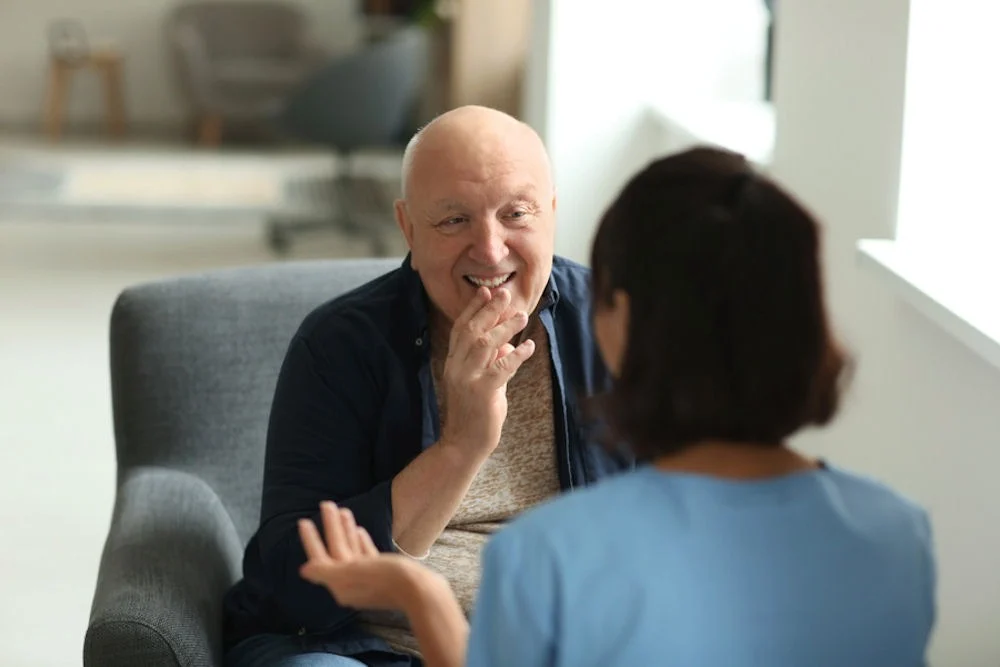PTSD is a condition that is ripe with anxiety and emotional distress. After all, a person suffering from PTSD has been through one or more traumatic events, either directly or indirectly that were so extreme or severe that it left them mentally scarred. While recovery from PTSD is possible, it is a long and sometimes difficult process that requires intense therapy in order to address not just the different aspects of the trauma but also the person’s overall emotional well-being.
Understanding these PTSD recovery stages can provide clarity and encouragement for not just those affected by PTSD but their loved ones as well. In this blog, we will explore the different stages of PTSD recovery, some of the more common challenges those with PTSD face during their recovery, the role therapy plays in recovery, and the importance of professional treatment.
PTSD and the Recovery Process
 As we touched on, Post-Traumatic Stress Disorder or PTSD is a complex mental health condition that develops in response to experiencing or witnessing a traumatic event. Due to the events surrounding the cause of PTSD and the complex nature of the condition, recovery from PTSD is a long and sometimes uncomfortable journey as the person suffering has to continue to relive the event that caused them severe mental trauma and anguish.
As we touched on, Post-Traumatic Stress Disorder or PTSD is a complex mental health condition that develops in response to experiencing or witnessing a traumatic event. Due to the events surrounding the cause of PTSD and the complex nature of the condition, recovery from PTSD is a long and sometimes uncomfortable journey as the person suffering has to continue to relive the event that caused them severe mental trauma and anguish.
This is why PTSD recovery often takes place in stages. Over time, through processing everything relating to their PTSD they can develop coping mechanisms so they can return to a fairly normal life and not have the traumatic event or events that lead to their PTSD control their life in a negative way anymore.
Why PTSD Recovery Happens in Stages?
In short, recovery happens slowly in stages due to the nature of the condition and the fact that it affects every person differently. Some people suffering from PTSD may experience an initial period of shock and denial, followed by emotional distress, while others might struggle with prolonged avoidance of traumatic memories.
As a result, treatment occurs in stages in order to address each individual aspect of trauma the person may be experiencing as well as focus on their emotional well-being.
So, with that in mind, let’s take a look at the different stages of PTSD recovery:
Stage 1: Recognition and Acknowledgment of Trauma
The first step in PTSD recovery is recognizing that trauma has had a profound impact on both your mental and emotional state.
Many people who suffer from PTSD suppress or even deny the severity of their trauma as an attempted coping mechanism. However, doing this can often end up making things worse and can even begin the cycle of substance abuse and addiction as the person looks for ways to continue to suppress their feelings through self-medication. By acknowledging the trauma though, instead of suppressing it, you can begin the healing process.
The first stage is when you will most likely:
- Identify your PTSD symptoms and how they affect your daily life
- Accept that the trauma was real and has had an effect on your mental health
- Understand that seeking professional help is not a sign of weakness but a way to recover
It’s not uncommon for someone in this stage to be in denial when it comes to their struggles and their need for help. Societal stigma around PTSD can contribute to feelings of shame or reluctance to acknowledge the impact of trauma, particularly when it comes to first responders or members of the military, either active or veterans.
Stage 2: Seeking Help and Beginning Treatment
Once you have acknowledged all of this, the next step is to seek out professional treatment. This involves finding a mental health professional that you trust, preferably one who specializes in trauma therapy, and enlisting their services. You can choose to go either the private practice route or you can go to a mental health treatment facility such as Laguna Mental Health. Your choice will likely come down to not just personal preference but also the type of services and care that you need.
When choosing which route to take, you may want to do the following:
- Have a consultation with a treatment professional to determine the best course of treatment.
- Learn more about your different treatment and therapy options such as cognitive-behavioral therapy (CBT), eye movement desensitization and reprocessing (EMDR), and medication.
It’s also important to remember that finding the right therapist or treatment plan can take time and just because one thing didn’t work doesn’t mean that treatment was a failure.
Stage 3: Processing Trauma and Emotional Healing
Once you have found a therapy option that you like, the next step is to begin processing the trauma and healing emotionally. While this is one of the most challenging stages of PTSD recovery, it is also one of the most important.
This stage involves facing difficult emotions and memories by:
- Working through past experiences with your therapist.
- Expressing emotions related to the trauma, such as fear, anger, guilt, or sadness.
- Beginning to reframe negative thoughts and replace them with healthier perspectives.
- Using therapeutic techniques to reduce the emotional distress associated with traumatic memories.
Stage 4: Developing Coping Strategies and Resilience
After you have begun the process of processing your trauma, the next step is to shift the focus to forming healthy coping mechanisms. These coping mechanisms can help with managing triggers while also reducing anxiety and regaining the feeling that you are in control of your emotions again.
This can be done by:
- Practicing mindfulness, meditation, and relaxation techniques.
- Engaging in physical activities, such as yoga or exercise, to reduce stress.
- Establishing healthy routines, including regular sleep and nutrition habits.
- Learning how to navigate PTSD triggers and employ grounding techniques.
By doing all this, it can help you regain the confidence to manage your PTSD symptoms in a healthy and productive manner.
Stage 5: Rebuilding Relationships and Daily Life
One of the often unintended consequences of PTSD is the strain it puts on your personal relationships. Stage 5 focuses on repairing and rebuilding those damaged relationships by rebuilding trust, strengthening social connections, and reintegrating into daily life.
This can be done by:
- Communicating openly with family and friends about PTSD and recovery.
- Re-establishing a sense of purpose through work, hobbies, or volunteering.
- Engaging in social activities to combat isolation.
- Setting boundaries to ensure emotional well-being while fostering healthy relationships.
Stage 6: Long-Term Management and Relapse Prevention
Much like other mental health conditions and substance use disorders, symptoms associated with PTSD can resurface and, when not handled properly can lead to relapse. That’s why long-term management and relapse prevention is so important.
Long-term recovery involves a combination of continued self-care, therapy, and awareness of potential relapse signs. Continuing to actively practice your coping strategies and engage in therapy, even after feeling better, can help maintain your long-term recovery.
Common Challenges During PTSD Recovery
While the stages of PTSD recovery may seem simple enough, it’s also important to remember that recovering from PTSD comes with plenty of challenges as well.
Some of the more common challenges you may face include:
- Fear of revisiting trauma – Many individuals struggle with confronting painful memories.
- Social stigma – Misconceptions about PTSD can make individuals hesitant to seek help.
- Emotional highs and lows – Progress is often non-linear, with periods of improvement and regression.
- Difficulty finding the right treatment – It may take time to find a therapist or treatment method that works best for an individual’s needs.
The Role of Therapy and Support Systems in PTSD Recovery
Therapy is one of, if not the most important aspect of PTSD treatment and recovery. Therapy provides a structured and evidence-based approach to healing, allowing you to properly manage your symptoms in a healthy manner moving forward.
Some therapies that are effective in treating PTSD include:
- Cognitive-Behavioral Therapy
- EMDR Therapy
- Group Therapy
How Long Does PTSD Recovery Take?
Since everyone experiences PTSD and the symptoms associated with it differently, there is no one-size-fits-all timetable for recovery. Some people may start to notice an improvement in their symptoms within a few weeks while, for others, it may take months or even years. The key to recovery is patience, persistence, and a willingness to seek help when needed.

Seeking Professional Help for PTSD
Seeking professional help is crucial to recovery as well. While many people may think they can just deal with their symptoms on their own, doing so can often lead to symptoms worsening on their own and, in turn, even leading to the development of additional mental or physical ailments, including substance abuse and addiction.
Learn More About the PTSD Recovery Stages at Laguna Mental Health
PTSD recovery is a journey that unfolds in stages, each contributing to overall healing. By understanding and embracing this process, individuals can navigate their path to recovery with greater confidence.
For more information about the states of PTSD recovery, or to learn more about the treatment and therapy services we offer, including for PTSD, contact us today.

 As we touched on, Post-Traumatic Stress Disorder or PTSD is a complex mental health condition that develops in response to experiencing or witnessing a traumatic event. Due to the events surrounding the cause of PTSD and the complex nature of the condition, recovery from PTSD is a long and sometimes uncomfortable journey as the person suffering has to continue to relive the event that caused them severe mental trauma and anguish.
As we touched on, Post-Traumatic Stress Disorder or PTSD is a complex mental health condition that develops in response to experiencing or witnessing a traumatic event. Due to the events surrounding the cause of PTSD and the complex nature of the condition, recovery from PTSD is a long and sometimes uncomfortable journey as the person suffering has to continue to relive the event that caused them severe mental trauma and anguish.